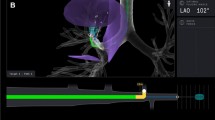Abstract
Background
There are few reports on a dual dye and isotope approach using laparoscopy in gastric cancer sentinel node mapping. The aim of this study is to evaluate the feasibility of laparoscopic sentinel basin dissection for gastric cancer using simultaneous indocyanine green (ICG) and 99mTc-antimony sulfur colloid (ASC) injections.
Methods
Sixty-eight patients were enrolled who had been diagnosed with cT1–T2 and cN0 stage gastric cancers. They underwent laparoscopic sentinel basin dissection between June 2005 and May 2008. ICG and 99mTc-tin colloid (separate injections in the first phase, n = 16) or ICG and 99mTc-ASC (simultaneous injections in the second phase, n = 52) were injected into the submucosa endoscopically. After performing the sentinel basin dissection, laparoscopy-assisted gastrectomy with curative lymphadenectomy was done. Green-stained or radioactive sentinel nodes (SNs) were analyzed by hematoxylin and eosin staining and by immunohistochemistry for cytokeratin.
Results
SNs were identified in 62 of the 68 patients (91.2%; mean 3.3 per patient). Eighteen patients had lymph node metastases. The sensitivity and specificity were, respectively, 72.2 and 100% using the dye method and 83.3 and 100% by the isotope method. However, the dual dye/isotope procedure improved both sensitivity and specificity to 100%. Patients receiving this protocol had significantly more SNs than those receiving separate ICG and 99mTc-tin colloid injections (3.3 vs. 1.9, P = 0.008).
Conclusion
Simultaneous ICG and 99mTc-ASC-guided laparoscopic sentinel basin dissection is an effective tool for gastric cancer SN mapping, giving a high detection rate and excellent sensitivity.


Similar content being viewed by others
References
Kim JP, Lee JH, Kim SJ, et al. Clinicopathologic characteristics and prognostic factors in 10,783 patients with gastric cancer. Gastric Cancer. 1998;1:125–33.
Lee HJ, Yang HK, Ahn YO. Gastric cancer in Korea. Gastric Cancer. 2002;5:177–82.
Ahn HS, Lee HJ, Yoo MW, et al. Diagnostic accuracy of T and N stages with endoscopy, stomach protocol CT, and endoscopic ultrasonography in early gastric cancer. J Surg Oncol. 2009;99:20–7.
Morton DL, Thompson JF, Essner R, et al. Validation of the accuracy of intraoperative lymphatic mapping and sentinel lymphadenectomy for early-stage melanoma: a multicenter trial. Multicenter Selective Lymphadenectomy Trial Group. Ann Surg. 1999;230:453–63.
Giuliano AE, Kirgan DM, Guenther JM, et al. Lymphatic mapping and sentinel lymphadenectomy for breast cancer. Ann Surg. 1994;220:391–401.
Veronesi U, Paganelli G, Viale G, et al. A randomized comparison of sentinel-node biopsy with routine axillary dissection in breast cancer. N Engl J Med. 2003;349:546–53.
Hiratsuka M, Miyashiro I, Ishikawa O, et al. Application of sentinel node biopsy to gastric cancer surgery. Surgery. 2001;129:335–40.
Kitagawa Y, Fujii H, Mukai M, et al. Radioguided sentinel node detection for gastric cancer. Br J Surg. 2002;89:604–8.
Hayashi H, Ochiai T, Mori M, et al. Sentinel lymph node mapping for gastric cancer using a dual procedure with dye- and gamma probe-guided techniques. J Am Coll Surg. 2003;196:68–74.
Kim MC, Kim HH, Jung GJ, et al. Lymphatic mapping and sentinel node biopsy using 99mTc tin colloid in gastric cancer. Ann Surg. 2004;239:383–7.
Park DJ, Lee HJ, Lee HS, et al. Sentinel node biopsy for cT1 and cT2a gastric cancer. Eur J Surg Oncol. 2006;32:48–54.
Kitano S, Shiraishi N, Uyama I, et al. A multicenter study on oncologic outcome of laparoscopic gastrectomy for early cancer in Japan. Ann Surg. 2007;245:68–72.
Kim W, Song KY, Lee HJ, et al. The impact of comorbidity on surgical outcomes in laparoscopy-assisted distal gastrectomy: a retrospective analysis of multicenter results. Ann Surg. 2008;248:793–9.
Kitagawa Y, Ohgami M, Fujii H, et al. Laparoscopic detection of sentinel lymph nodes in gastrointestinal cancer: a novel and minimally invasive approach. Ann Surg Oncol. 2001;8:86S–9S.
Tonouchi H, Mohri Y, Tanaka K, et al. Laparoscopic lymphatic mapping and sentinel node biopsies for early-stage gastric cancer: the cause of false negativity. World J Surg. 2005;29:418–21.
Japanese Gastric Cancer Association. Japanese Classification of gastric carcinoma. Gastric Cancer. 1998;1:10–24 (2nd English Edition).
Jeong JM, Hong MK, Kim YJ, et al. Development of 99mTc-neomannosyl human serum albumin (99mTc-MSA) as a novel receptor binding agent for sentinel lymph node imaging. Nucl Med Commun. 2004;25:1211–7.
Henze E, Schelbert HR, Collins JD, et al. Lymphoscintigraphy with Tc-99m-labeled dextran. J Nucl Med. 1982;23:923–9.
Nimura H, Narimiya N, Mitsumori N, et al. Infrared ray electronic endoscopy combined with indocyanine green injection for detection of sentinel nodes of patients with gastric cancer. Br J Surg. 2004;91:575–9.
Tajima Y, Yamazaki K, Masuda Y, et al. Sentinel node mapping guided by indocyanine green fluorescence imaging in gastric cancer. Ann Surg. 2009;249:58–62.
Miwa K, Kinami S, Taniguchi K, Fushida S, Fujimura T, Nonomura A. Mapping sentinel nodes in patients with early-stage gastric carcinoma. Br J Surg. 2003;90:178–82.
Lee YJ, Ha WS, Park ST, et al. Which biopsy method is more suitable between a basin dissection and pick-up biopsy for sentinel nodes in laparoscopic sentinel-node navigation surgery (LSNNS) for gastric cancer? J Laparoendosc Adv Surg Tech A. 2008;18:357–63.
Acknowledgment
This study was supported by a grant of the Korea Healthcare Technology R&D Project, Ministry for Health, Welfare, and Family Affairs, Republic of Korea (A085125).
Author information
Authors and Affiliations
Corresponding author
Rights and permissions
About this article
Cite this article
Park, D.J., Kim, HH., Park, Y.S. et al. Simultaneous Indocyanine Green and 99mTc-Antimony Sulfur Colloid-Guided Laparoscopic Sentinel Basin Dissection for Gastric Cancer. Ann Surg Oncol 18, 160–165 (2011). https://doi.org/10.1245/s10434-010-1221-y
Received:
Published:
Issue Date:
DOI: https://doi.org/10.1245/s10434-010-1221-y




